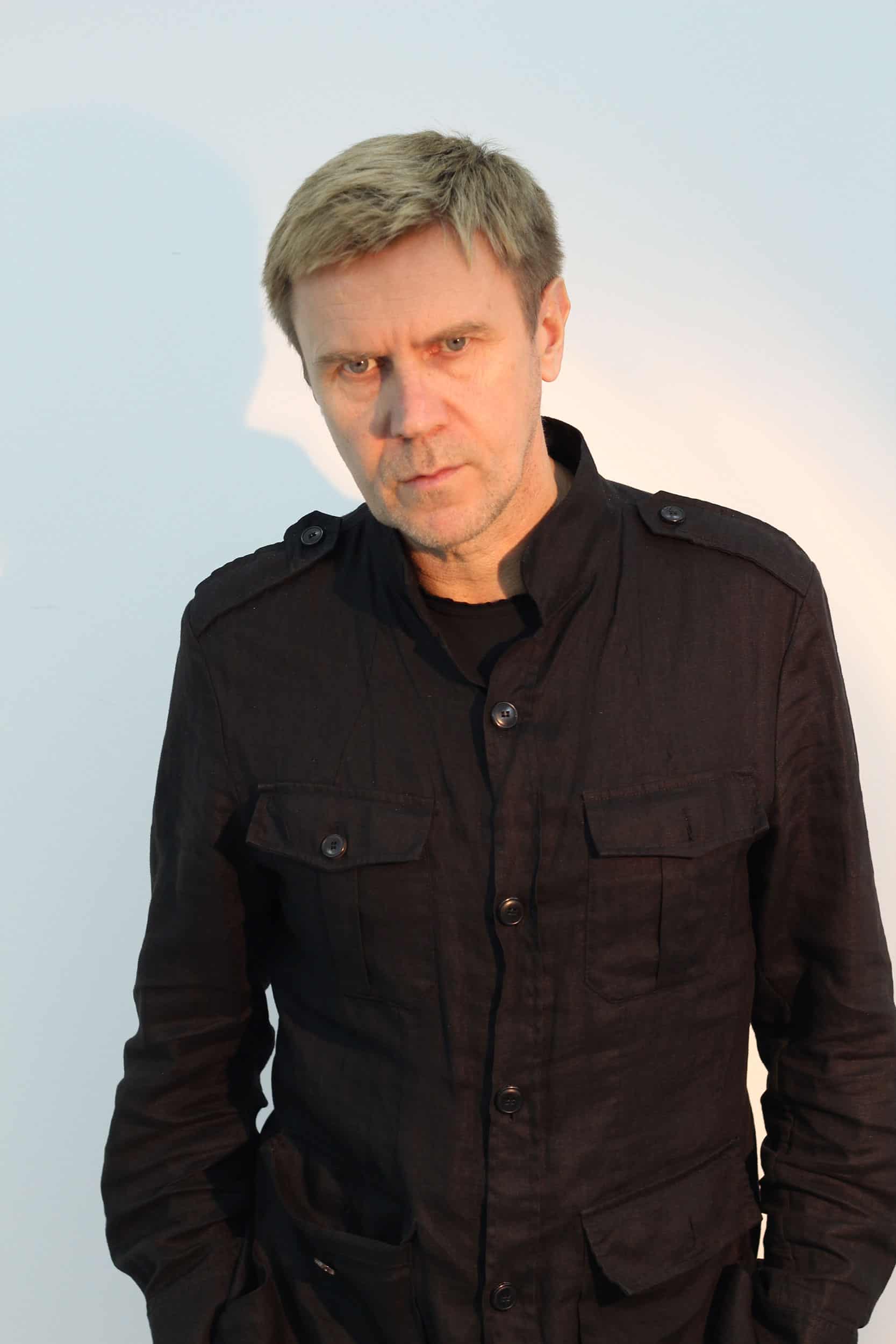©Studio Miroslaw Bałka
Michalina Sablik: We’re having this conversation against the backdrop of the Action Lublin! Chapter 2 exhibition held at the Galeria Labirynt in Lublin. It juxtaposes performance art of your students with those executed by its pioneers in Poland, including Jan Świdziński, Jerzy Bereś, Teresa Murak and Zbigniew Warpechowski. Do your students draw on the ideas of the Neo Avant-Garde? Are they familiar with or in any way inspired by their oeuvre?
Mirosław Bałka: It depends. Performance art is by no means at the core of my studio’s programme. I run the Studio of Spatial Activities where the scope of the study is much broader. We act outside, go way beyond the walls of the academy or art gallery. Meanwhile, performance imposes certain limitations. It’s hard to tell whether everyone derives inspiration from the back catalogue of the artists you’ve just mentioned since we don’t officially tackle this subject during classes. The course content dispenses with an investigation into the art practice of the 1970s performers, perhaps with the exception of Zbigniew Warpechowski whom we met in Lublin several years ago. We prefer to look at a bigger picture of an international contemporary art scene.
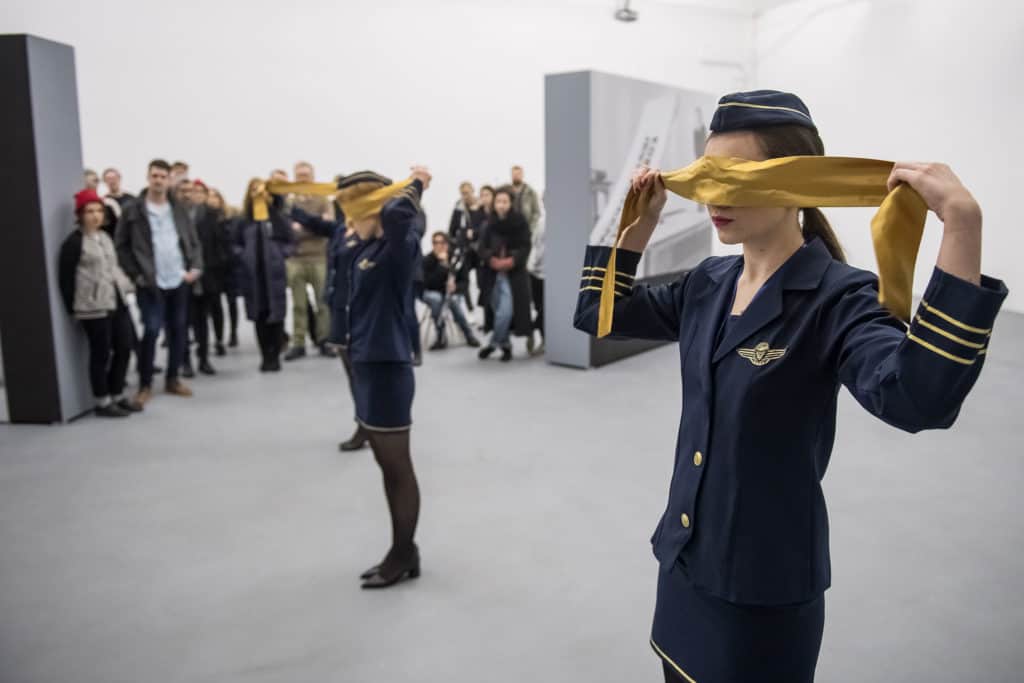
Performative actions: Julia Dorobińska, Marta Nowak, Anna Shimomura; photo Wojciech Pacewicz
M.S.: What aspects of performance art have changed since the 1970s? It seems to me that performance for the camera, an act meditated through another medium and its documentation have recently achieved greater prominence.
M.B.: On-camera performance dates back to the 1960s when Bruce Nauman walked around his studio while playing the violin and making body movements influenced by Beckett. Performance art has always been contingent upon a camera record, its essential artistic component. It’s difficult for me to address the changes in the field. I don’t teach performance art. I teach people how to think and produce art. Back in the 1970s, I was neither a student of nor an enthusiast of performance. It wasn’t until the 1980s that I’ve gained some insight into performance art.

Performative actions: Svitlana Bezkorovaina, Barbara Gryka, Nadia Markiewicz; photo Wojciech Pacewicz
M.S.: Was it a crucial point of reference for you, then?
M.B.: Performance, or any human artistic activity for that matter, is a fascinating manifestation of gesture. We, the art group Consciousness Neue Bieriemiennost specialised in the quasi-performance we dubbed “active vernissage” that involved all forms of creative activities. Personally, I associate performance with awkwardness. You stand embarrassed in an enclosed space, in front of an undressing person – usually male. Performance has never been my point of reference, not at all.
M.S.: Nowadays, the lines between art disciplines are blurred. Your students must work across all kinds of media, installation, sculpture, performance, video art, happenings etc. Their art practice can’t be limited to a single medium.
M.B.: Well, obviously. We focus on the eponymous spatial activities, plural.
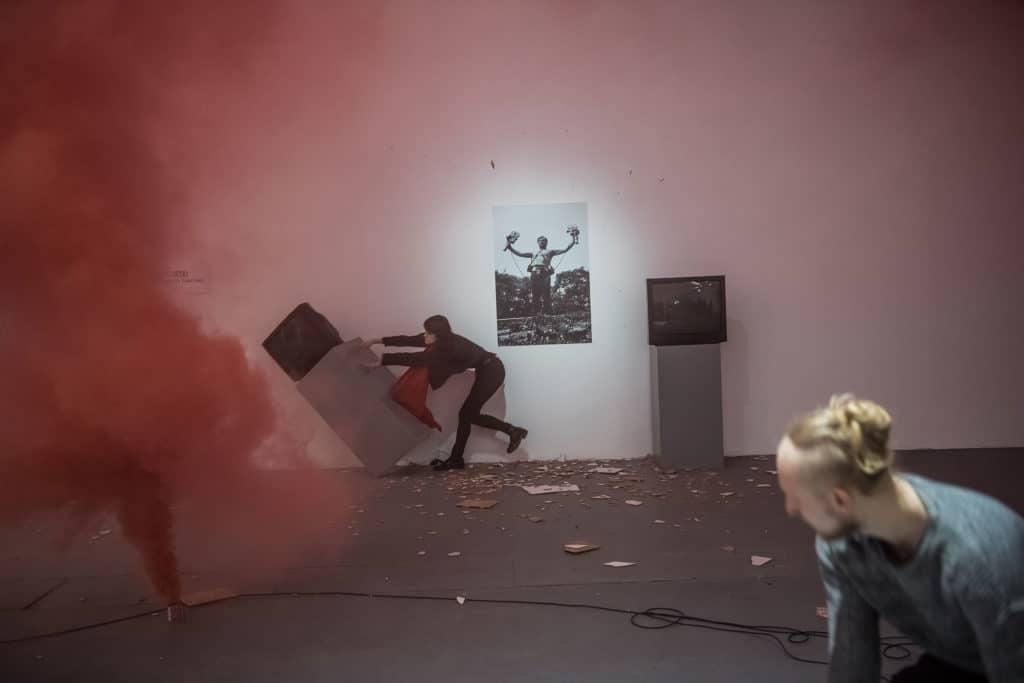
Performative actions: Jonasz Chlebowski, Mateusz Kowalczyk, Oliwia Thomas; photo Wojciech Pacewicz
M.S.: Could you elaborate on one’s “development of sensitivity towards space” you cite as one of your studio practice’s primary goals? What do you mean by that?
M.B.: Our studio practice has humanistic underpinnings. In my opinion, you reach for a tool you deem most appropriate if you feel an intrinsic need to implement an idea. The most sophisticated works of art, and I don’t mean painting, but rather the ephemeral activities by for instance Bruce Nauman or Robert Smithson, Robert Morris or Fluxus, originated from a specific need rather than a specific tool, even though later they would be labelled on the basis of the tool as, for example land art or minimal art. Thinking is key. Thinking galvanises you into action, location scouting and execution of a piece on your own accord. My role as a professor boils down to pointing my students towards potent places and areas. In 99% of the cases, the selected locations are as far from the academy or art gallery as you can imagine. If we do enter into an art gallery, I expect my students to respond somehow to its spatial context, to defy its conventions. Although I find the Labirynt in Lublin the most artist-friendly gallery in the country, I still look forward to seeing them engage in a dialogue with its institutional framework. A notable example would be “Pogo,” the cult performance initiated by my students from Poznań many years ago, who decided to bash a hole into the BWA Zielona Góra’s wall and thus decompress it. Needless to say, Wojtek Kozłowski, the BWA director and an exceptionally open-minded person supportive of young artist’s endeavours, had previously given us his consent.
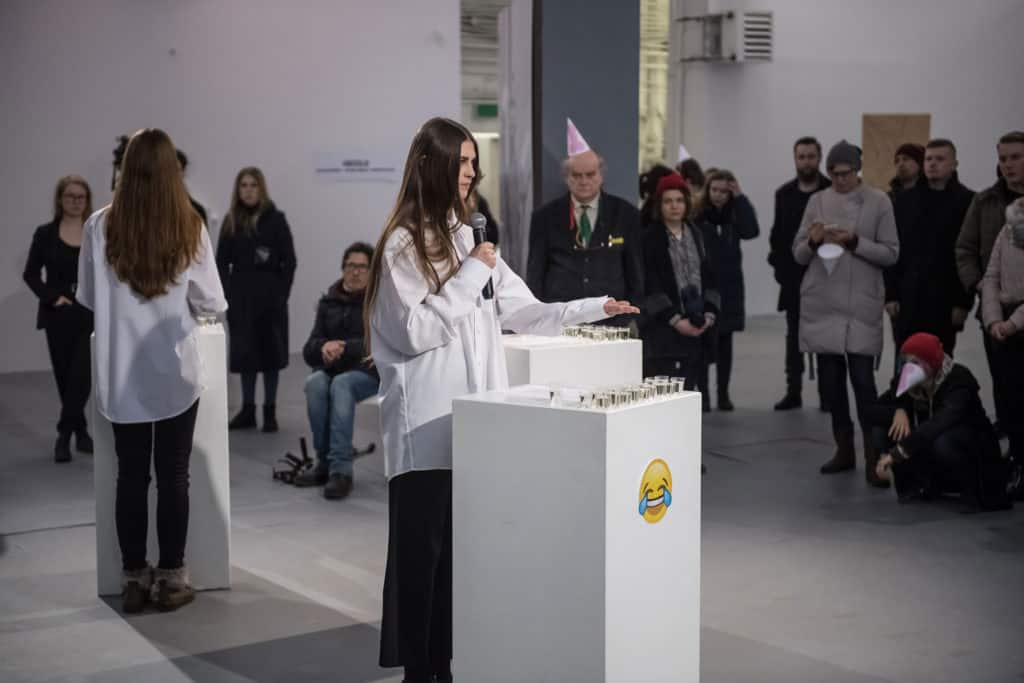
Performative actions: Izabela Bartman, Bożna Wydrowska, Alicia Montserrat; photo Wojciech Pacewicz
M.S.: Artworks created in your studio build micronarratives and highlight their local and autobiographic potential (e.g. Michalina Ludmiła Musielak’s graduate project “Audience”). Do the micronarratives evoke some universal truth about the humanity?
M.B.: Our bodies, which interact with the world, are built from cells and particles. Analogously, to construct an all-encompassing narrative, one needs to start from within, from their singular micronarrative. That’s where artistic credibility comes from. However, the ratio is never 1:1 but is multiplied by some factor, often lower than 1. Our work method relies mostly on research into a location, its history, background, political context etc. This stage is of paramount importance to the process. I advocate an inquisitiveness, poring over a project, place and another human being. My dedication to the act of “poring over things” carries an educational value.
M.S.: As a result, your students, such as Jana Shostak and Agnieszka Nowak, create excellent, critical, socially-engaged artworks. How do you instil social awareness? Is the knowledge of recent research in sociology considered a requirement?
M.B.: Our students are offered the list of recommended reading that omits critical writings. We assume the role of chefs, not waiters in the restaurant. We select a raw material which is then prepped and processed. The level of social and political awareness differs among my students. It depends on their personal beliefs. The studio is quite accommodating, operating as the agora that lends a spirit of erudition to the proceedings. Our students cherish the openness we demonstrate, make progress, and I’m there to provide them with assistance. We’re open. Our open studio embodies the notion of the open form put forward by Oskar Hansen, who would nowadays create something different from the pieces he made in the 1980s. That’s the thing about development. My students help me develop, too.
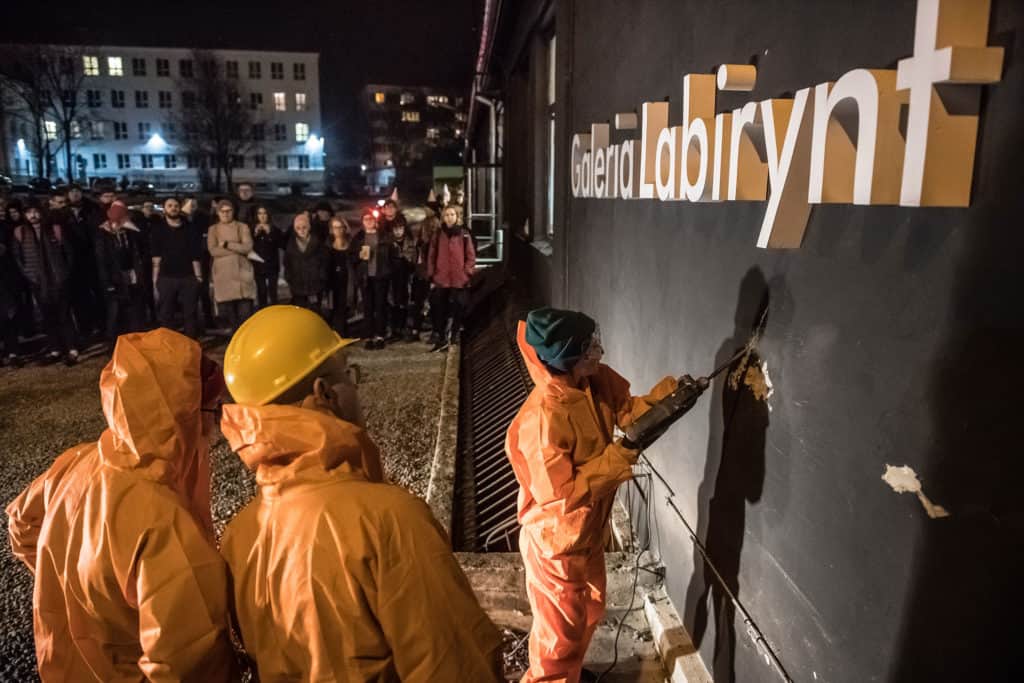
Performative actions: Tymoteusz Bryndal, Piotr Marzec, Agnieszka Mastalerz; photo Wojciech Pacewicz
M.S.: What immediately springs to mind when I consider the issues of space, social awareness and sculpture is Joseph Beuys’ theory of “social sculpture.” Are his ideas even relevant to your studio practice and modern society in general?
M.B.: I think so. Beuys’s understanding of art keeps resonating with today’s people. The unadorned Beuys, stripped off embellishments with only the “social sculpture” or display cases remaining (which I was obsessed with as a student), has been held in high regard for many years now and greatly appreciated. The world used to be more tangible, its structure more physical and material. Nowadays, the object fades away, while ephemeral actions, essentially outlets for your energy and thoughts which are firmly rooted in performance art, take precedence.

Performative actions, Jagoda Kwiatkowska, Katarzyna Los, Artur Prymon; photo Wojciech Pacewicz
M.S.: You’ve mentioned how important it is for you to transcend the four walls of an art gallery or the academy. For this reason, you frequently organise excursions and field trips to Otwock or Dublin, for instance. In what way do they foster students’ further development?
M.B.: The aim is for our students to realise that their time at the academy is merely a period of transition and soon they will go out into the non-academic, adult world. After my own graduation, I struggled to come to terms with reality because I wasn’t prepared for it. Therefore, I share some pieces of information with them, so they know what to expect.
M.S.: One could draw parallels between these field trips or workshops and the representatives of the Neo Avant-Garde movement. Apparently, the creative brainstorming sessions of the Neo Avant-Garde artists were held in remote locations, too. Undoubtedly, those excursions’ goal of honing one’s practical skills while observing nature was rendered obsolete, so what’s the purpose of today’s en plain air trips for the artists?
M.B.: ‘En plain air’ is a wrong word. Fortunately, I’ve never participated in such trips, even in my student days, and I avoid them now. From my standpoint, we organise workshops that run counter to the meetings you’ve just referred to, which, to be fair, made a profound contribution to art history. The zoo on tour that came to town, welcomed not only artists but also art critics who tagged along. On the other hand, we take our journeys to examine the terrain in an anthropological and archeological manner. Our approach differs completely. We shun colonialism. Like I said, our task is to “pore over things.” Whereas by all accounts (and I might be mistaken because I didn’t witness the events first-hand), the Neo Avant-Garde meetings were attended by insiders only, the seminal artists of the period. We attempt to interact with others, neither our followers nor art critics or art historians who would give their seal of approval to the project after its presentation.
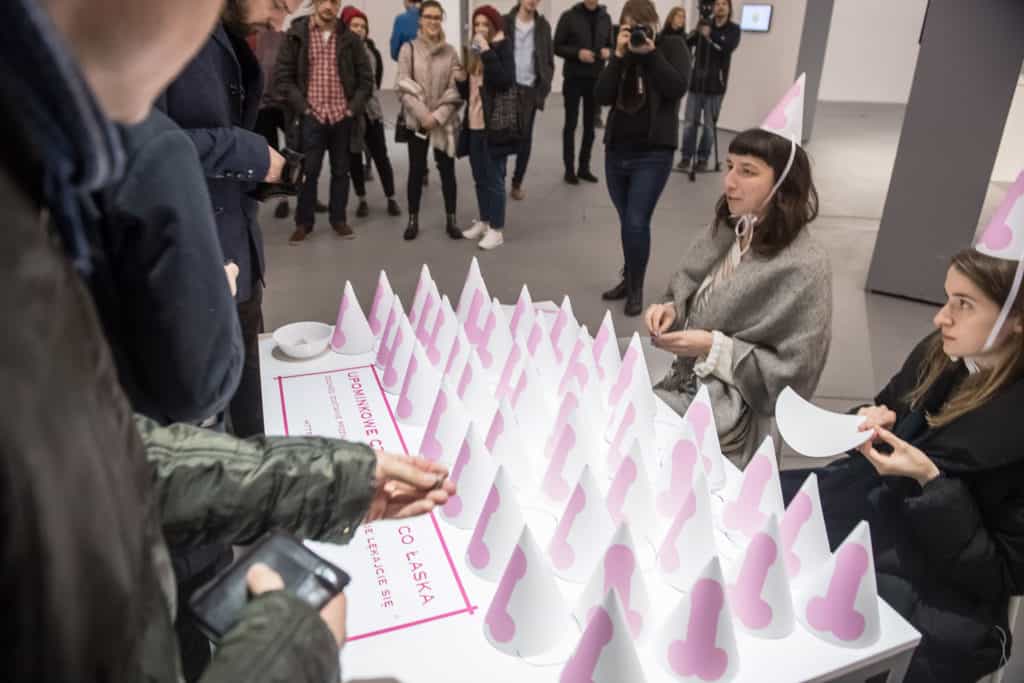
Performative actions: Julia Golachowska, Antonina Nowacka, Weronika Wysocka; photo Wojciech Pacewicz
M.S.: Video footage from your workshops features relaxed people fooling around and enjoying themselves. “Polen Performance” and Kamil Kotarba’s works demonstrate a sense of humour and irony. Are those qualities vital to you?
M.B.: Those qualities are inextricably linked to an individual’s cognitive faculties allowing them to interpret and make fun of the world around them. I’ve known some artists for thirty years now, even the most solemn ones like Luc Tuymans, are perfectly capable of joking around and having a whale of a time. I’m proud of my students with a sense of humour who refuse to succumb to peer-pressure and have managed to create a most joyful atmosphere in the studio. Somehow, they aren’t a bundle of nerves worrying about what others are doing. After they graduate, the shared value they’ve established together will make their lives as professional artists easier as long as they remain freethinkers. Intelligent people can laugh!
M.S.: Allow me to broach the subject of a student-teacher relationship. Despite many art critics, artists and gallery owners have hailed you as the master or guru of contemporary art, you managed have friendly relationships with students based on dialogue and equality. What’s your secret? How did you arrive at your teaching methods and are they beneficial to both parties involved?
M.B.: I haven’t got the faintest idea. If you wish to delve into some (if any) mutual benefits, you should go ahead and ask my students about them (laughs). I branched out into teaching when I was in my forties, relatively late, I think. Consequently, I didn’t have to climb the career ladder and raise to the higher rank in the enduring academic hierarchy. I entered the stage as an acclaimed artist who’s had ample occasions to experience a friendly collaboration between people from various generations and backgrounds while staging an exhibition (even though preparing an exhibition is by no means a democratic process). Common goal unites individuals regardless of their age, gender and other factors. In the studio, we’re all equal. Personally, I get down off my high horse that I mount once in a while, particularly during my exhibition openings. I turn it down a notch, engage in a conversation and take my cues from the directors of important galleries in the West, who always ask me if I want to be on first-name terms with them straight away. Meanwhile, a rigid institutional hierarchy among directors and curators persists in Poland. The Western approach is much less formal.

Performative actions: Jonasz Chlebowski, Mateusz Kowalczyk, Oliwia Thomas; photo Wojciech Pacewicz
M.S.: The academies of fine art in Poland are more traditional. Their education programmes emphasise artistic craft. The studios offering workshops in new media art have emerged quite recently. How does the Studio of Spatial Activities fit into this academic model? Is your teaching philosophy still a curious novelty or have other studios followed suit?
M.B.: It fits very well, thank you. I can’t complain about the shortage of students who sign up for the course. Comparisons with other studios at the Academy are hard for me to draw, however. Our ideas (of togetherness, for instance) are snatched by other teachers. According to our cardinal rule, we always sit in a circle because we must be able to look each other in the eyes and not the backs of those in the front row. The classroom routine of a professor preaching to his congregation from the podium is thus abolished. Our approach, the hallmark of the Western teaching methods, is spreading. In progressive countries, even school desks are positioned differently. In Poland, and especially now, all eyes must still focus on the blackboard, cross, crowned white eagle and the “1944, we remember!” emblem.
As far as craft is concerned, I believe that thinking is a piece of craftsmanship, and I teach people to think in the Studio of Spatial Activities. Mental acumen requires serious talent and practice. Like I said at the beginning of our conversation, manual labour comes later. Visual arts have finally managed to throw off the shackles of their chiefly visual and aesthetically pleasing nature in favour of interactivity and resonance with the viewer. In my opinion, the Media Art Faculty concerned with the education in new media and interdisciplinary art practice should stand for innovation and break new ground in the world.
M.S.: What’s your ideal academy of fine arts? What elements should come together to meet the needs of young contemporary artists?
M.B.: My ideal academy is where my studio is. If only I could’ve been assigned a separate studio and a place for storing my students’ works. Every academy has an intricate internal structure that can’t easily be updated. The process will continue to go on. Nonetheless, new faculties, departments and studios with diverse programmes tailored to the students’ areas of interest herald the imminent changes. Why can’t we account for the needs of those passionate about painting and sculpture? Students must have options, experience a broad spectrum of art disciplines. And the modern academy should enable them to do so and preserve art’s multiplicity. The formula could certainly be refreshed by someone other than me, however. I’m lucky to have my hands full with my numerous creative activities. I view my tenure mainly in terms of a creative challenge, something more than my public duty to educate young people.
Action Lublin! Chapter 2
26 January — 18 March 2018, Galeria Labirynt
Performative actions by the students from the Studio of Spatial Activities took place 9 March 2018.

Performative actions: Conrad Hübbe, Billy Morgan, Michał Szaranowicz; photo Wojciech Pacewicz




